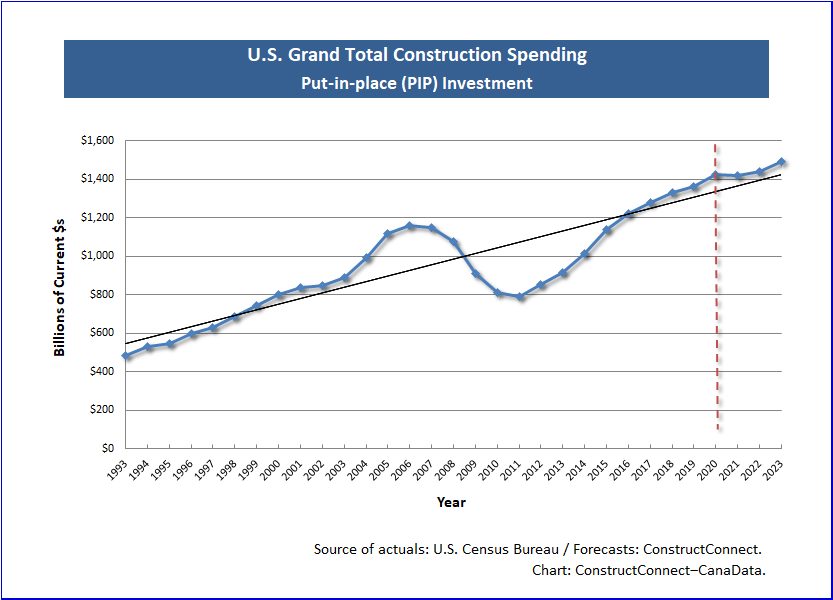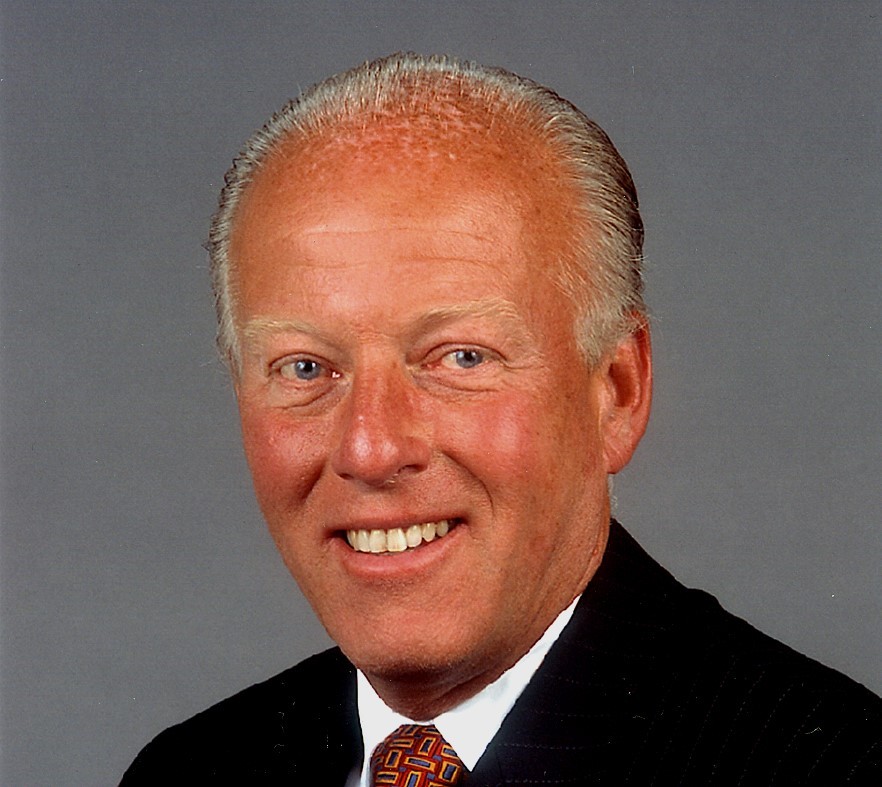2021 State of the Industry
by Paul Deffenbaugh | 4 January 2021 12:00 am
Following one of the most difficult years in decades, the industry looks forward to a more positive 2021.

Still, the metal construction industry fared better than most industries, and for that we should be grateful.
Coming into 2021, our State of the Industry participants retain their sense of optimism, but this time it is less likely to be undone by the unforeseeable. As we write this, COVID-19 vaccines are being distributed, and predictions are that every American will be vaccinated by June. Again, we should be grateful.
The future seems to be brighter than it has in many years past, especially because we are emerging from such dark times. But identifying what part of the uncertain future holds the most promise is now our charge, and the following pieces will, we hope, give you a sense of direction.

2021 U.S. Put-in-Place Construction Outlook
By Alex Carrick, Chief Economist, ConstructConnect
While the U.S. economy is in recovery mode, it remains under stress in a fashion not seen in more than a century. The onset of the coronavirus health crisis in the spring caused an unprecedented collapse in economic activity that is being reversed, but more gradually than was initially expected. Hopes for a smooth progression of upwards growth to flow from store and restaurant re-openings have been waylaid by a winter upsurge in COVID-19 infections, with the prospect that demands on the health care system will worsen before beginning to ease once again.
On the upside, effective vaccines developed by several pharmaceutical companies will soon be available to protect the most vulnerable members of the public, with wider distribution to proceed over the first half of next year.
[11][12]READ MORE[13]

A New Workforce Development Coalition
By Tim Seyler, President, Metal Building Institute
Currently, construction firms across the country report challenges with filling job openings in all aspects of their businesses. “Workforce shortages remain one of the single most significant threats to the construction industry,” Stephen E. Sandherr, Associated General Contractors’ CEO, recently said in a statement.
According to the U.S. Bureau of Labor Statistics (BLS), there were about 300,000 vacancies in the construction industry as of June 2020. The industry is expected to need 747,000 more employees by 2026. That is a 6.6% increase over the current 11 million people employed in the industry, for an average annual growth rate of about 1.0%
Achieving that objective is not likely, considering that BLS also reports that total U.S. employment is projected to grow only 0.4% annually through the decade 2019 to 2029. That is in comparison to the 1.3% annual growth rate experienced from 2009 to 2019. This reduction in the labor force growth rate is due, in part, to an aging population and slower population growth among Latinos, trends which are not reversible.
[14][15][15]READ MORE[16]

A Slow Beginning and a Strong End to 2021
By James Bush, Chair, Metal Construction Association
As we enter the new year, the unprecedented events of 2020 will remain with the industry and the world for a long time. Recent news is promising—early success appears to have been made with upcoming vaccines and a sense of normalcy may be in sight—but lingering questions remain.
From a business perspective, most of those in metal construction appear to have weathered 2020 well. Most individuals in my circles appear to have stayed strong throughout the year in both incoming sales and shipments.
My most concerning aspect as we move forward is that the reported number of new construction starts in the nonresidential sector for 2020 are down about 25% compared to 2019, according to information from industry sources. At some point in 2021, this number is bound to catch up to those in this market segment. Though the drop in nonresidential construction will catch up to us at some point in 2021, the effects of the depressed starts in 2020 will be spread out during the latter half of 2021 and into 2022. The one shining star for our industry for 2020 appears to be in the residential sector, for both remodeling and new construction.
[17]READ MORE[18]
Metal Buildings and Small Businesses Meet Opportunity and Challenges
By Art Hance, President, Metal Building Contractors & Erectors Association
Sometimes we volunteer for things and then realize just how difficult fulfilling that promise can be. Predicting what our industry will look like in 2021 is anyone’s best guess when faced with the effects of COVID-19, an unknown outcome of widespread vaccination, a new administration, issues related to trade, and the likelihood of international conflicts which will impact oil and commodities. I hope I will be lucky, my insights will be accurate and all you readers will comment about how smart I am!
The above-mentioned challenges play out daily in every business in our country, especially for small business. Owner’s make decisions based on their level of confidence that if they move ahead with a project, they will be able to address the debt service incurred. While our company has been blessed with the largest year-over-year increase in our history, l am still cautious in how I deploy our resources to position us for growth, while protecting us should we experience another catastrophic downturn.
[19][20]READ MORE[21]

The Future of Architecture is Resilience and Nature in Design
By Rick Harlan Schneider, AIA, APA, LEED AP, Principal, ISTUDIO Architects, Washington, D.C.
Emulating nature in design is the key to a more resilient future. Designing buildings and cities this way requires understanding powerful forces like the sun, wind and rain, then harnessing them to create healthier built places and improve ecosystems. When it’s done right, this form of biomimicry helps to mitigate climate change as it gives us strategies for climate adaption.
Buildings that Breathe
We’re relearning how to make our buildings breathe, combining the best of new smart building technology and age-old principles of nature. Two case studies in Washington, D.C., provide examples of solar chimneys and building-automated natural ventilation. External conditions are measured with a rooftop weather station that communicates with the building systems. When conditions are right— temperature, humidity, wind speed and direction—the building HVAC automatically goes into passive mode. Windows and wall-mounted louvers on the first floor open to let in cooler air and expel it through rooftop solar-powered exhaust fans on the second floor. The building takes in a breath of fresh air and lets it out.
[22][23]READ MORE[24]
Emerging from Uncertainties of 2020, the Future for Residential Metal Roofing Looks Bright
By Renee Ramey, Executive Director, Metal Roofing Alliance
It’s an understatement to say 2020 was a year like no other, one that not only tested the resiliency of families and communities throughout the globe, but the resiliency of the industry and market.
So how did the rollercoaster-like conditions of 2020 affect the metal roofing industry and more importantly, how has it changed the landscape of what lies ahead? This past year revealed truths and trends that may continue to impact the industry in both positive and negative ways for the foreseeable future, including:
- Home Havens: The sanctity of home has become paramount, with families spending more time at home than ever. This has led to increases in home improvement budgets and projects, and interest in investing in quality upgrades designed to last.
[23]READ MORE[25]

Endure Today’s Challenges and Be Stronger Tomorrow
By Tony Bouquot, General Manager, Metal Building Manufacturers Association
One of the roles of an association manager is to be a cheerleader for his industry. After technical projects, marketing is the second largest line item in the Metal Building Manufacturers Association (MBMA) budget. But even the most enthusiastic cheerleader would be forgiven for feeling a bit pessimistic at the end of 2020.
However, reflecting on the state of the metal building industry, I’m reminded of the Spartan cheerleaders sketches from Saturday Night Live in the mid-90s. No matter how bad things were going around them at the chess tournament, outcast cheerleaders, Will Ferrell and Cheri Oteri, were always able to come up with the perfect cheer.
[23]READ MORE[26]

Design Blasted into a New Future
By Frank Stasiowski, FAIA, CEO, PSMJ Resources Inc.
Blasted into the future by COVID-19, today’s professional design firms worldwide are one of the best positioned businesses to profit immensely as we move toward our new normal society in 2021.
I’ve predicted for years that the 2020s will echo memories of the Roaring ’20s from a century ago, so now let me explain why this is proving truer with each passing day.
Primed Before COVID-19
Architects and engineers worldwide have spent hundreds of millions of dollars over the past 50 years on the hardware and software necessary to change the entire delivery process from paper to totally interconnected electronic delivery of design. In the 1980s, we at PSMJ created and owned the largest computer technology tradeshow (AEC Systems) for design professionals with an annual attendance near 30,000 and over 2000 exhibiting companies, propelling the entire design industry into the 21st century long before COVID-19.
[23]READ MORE[27]
- 2020 Report: https://www.metalconstructionnews.com/articles/2020-state-of-the-industry
- 2019 Report: https://www.metalconstructionnews.com/articles/2019-state-of-the-industry
- 2018 Report: https://www.metalconstructionnews.com/articles/2018-state-of-the-industry
- 2017 Report: https://www.metalconstructionnews.com/articles/2017-state-of-the-industry
- 2016 Report: https://www.metalconstructionnews.com/articles/2016-state-of-the-industry
- 2015 Report: https://www.metalconstructionnews.com/articles/2015-state-of-the-industry
- 2014 Report: https://www.metalconstructionnews.com/articles/2014-state-of-the-industry
- 2013 Report: https://www.metalconstructionnews.com/articles/2013-state-of-the-metal-construction-industry
- 2012 Report: https://www.metalconstructionnews.com/articles/2012-state-of-the-industry
- 2011 Report: https://www.metalconstructionnews.com/articles/mcn-jan-2011-state-of-the-industry
- : https://www.metalconstructionnews.com/articles/put-in-place-construction-forecasts
- : https://www.metalconstructionnews.com/articles/the-tipping-point
- READ MORE: https://www.metalconstructionnews.com/articles/u-s-put-in-place-construction-outlook
- : https://www.metalconstructionnews.com/articles/reinventing-the-green-movement
- : https://www.metalconstructionnews.com/articles/growth-of-zero-energy-buildings
- READ MORE: https://www.metalconstructionnews.com/articles/a-new-workforce-development-coalition
- : https://www.metalconstructionnews.com/articles/complexity-and-interconnectedness-of-building-enclosure-components-drives-demand-for-consultant-input
- READ MORE: https://www.metalconstructionnews.com/articles/a-slow-beginning-and-a-strong-end-to-2021
- : https://www.metalconstructionnews.com/articles/metal-roofing-forecasts-and-trends-for-2019
- : https://www.metalconstructionnews.com/articles/investing-in-innovation-and-changing-the-narrative
- READ MORE: https://www.metalconstructionnews.com/articles/metal-buildings-and-small-businesses-meet-opportunity-and-challenges
- : https://www.metalconstructionnews.com/articles/help-wanted-no-good-help-wanted
- : https://www.metalconstructionnews.com/articles/marketing-becomes-mission-critical-for-construction-products-and-services
- READ MORE: https://www.metalconstructionnews.com/articles/the-future-of-architecture-is-resilience-and-nature-in-design
- READ MORE: https://www.metalconstructionnews.com/articles/emerging-from-uncertainties-of-2020-the-future-for-residential-metal-roofing-looks-bright
- READ MORE: https://www.metalconstructionnews.com/articles/endure-todays-challenges-and-be-stronger-tomorrow
- READ MORE: https://www.metalconstructionnews.com/articles/design-blasted-into-a-new-future
Source URL: https://www.metalconstructionnews.com/articles/2021-state-of-the-industry/

